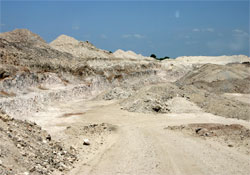Latest NewsLimestone supplier diversifies products and services
|
NewsUltra-Fine Lime: Pilot Plant Construction and CommissioningBackgroundAcid mine drainage (AMD) is produced by the oxidation of sulphide minerals, mainly iron pyrite or iron disulphide (FeS₂). This is a natural chemical reaction which can proceed when minerals are exposed to air and water. Acidic drainage is found around the world both as a result of naturally occurring processes and activities associated with land disturbances, such as highway construction and mining where acid-forming minerals are exposed at the surface of the earth. These acidic conditions can cause metals in geologic materials to dissolve, which can lead to impairment of water quality when acidic and metal laden discharges enter waters used by terrestrial or aquatic organisms. Considering the vast number of publications on Acid Mine Drainage (AMD) and the treatment thereof, the long-term impact on the local ecological area must be understood as well as how to treat the problem in a sustainable manner. There are two main treatment processes available:
Calmasil Development
Based on the performance of the product and ability to classify < 106 µm product, Calmasil has completed the basic design of a full scale plant that will yield ±4000mt per month of ultra-fine limestone. Calmasil Prima with a pH >12 and a C.C.E of ±100 % on its own is an extreme cost effective alternative to CaO (Unslaked lime) and CaOH (Slaked lime). The increased reactivity due to particle size reduction is set to result in vast performance improvements compare to the standard product, assisting in stabilizing the pH levels in the AMD ensuring that the pH level is at the required level. Calmasil projects that the full scale plant will be constructed and commissioned by end March 2012. We intend to keep everyone up to date as we reach our various milestones in this project. |





